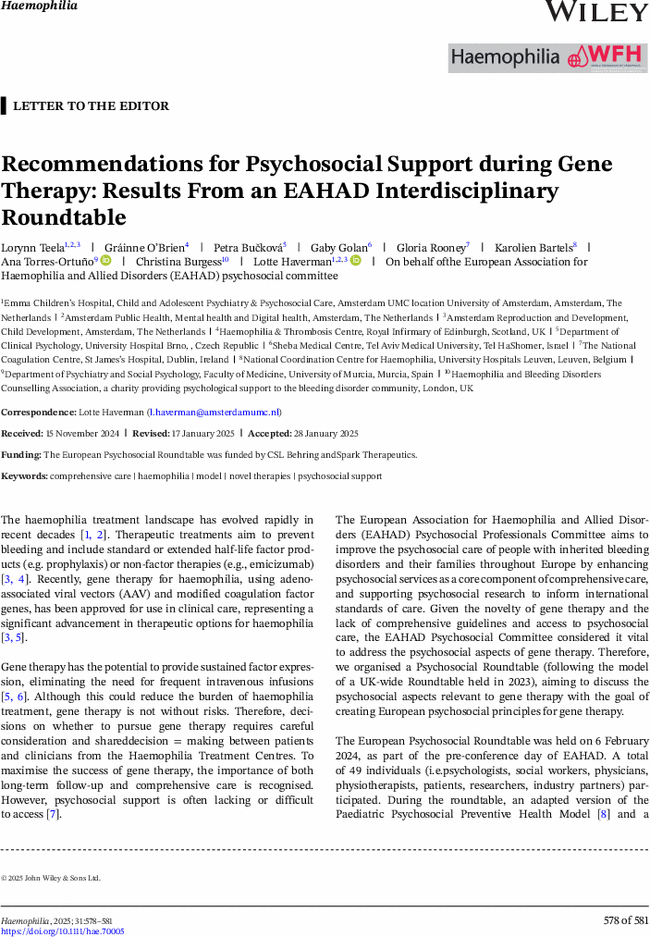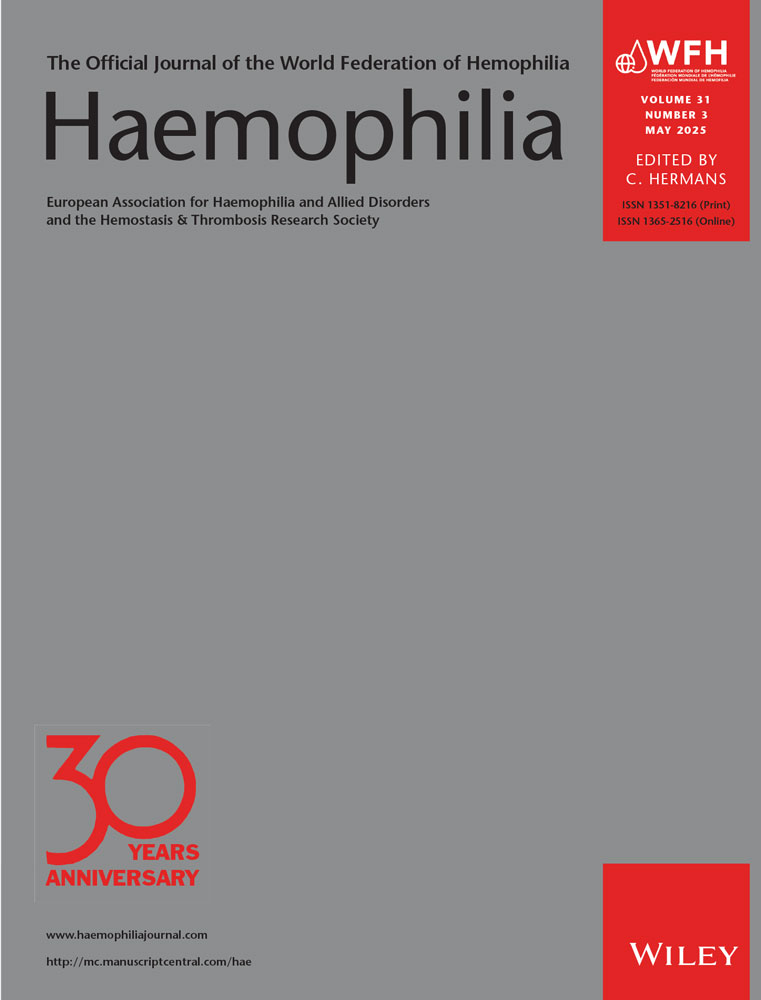Recommendations for Psychosocial Support during Gene Therapy: Results From an EAHAD Interdisciplinary Roundtable
Lorynn Teela
Emma Children's Hospital, Child and Adolescent Psychiatry & Psychosocial Care, Amsterdam UMC location University of Amsterdam, Amsterdam, The Netherlands
Amsterdam Public Health, Mental health and Digital health, Amsterdam, The Netherlands
Amsterdam Reproduction and Development, Child Development, Amsterdam, The Netherlands
Search for more papers by this authorGráinne O'Brien
Haemophilia & Thrombosis Centre, Royal Infirmary of Edinburgh, Scotland, UK
Search for more papers by this authorPetra Bučková
Department of Clinical Psychology, University Hospital Brno, , Czech Republic
Search for more papers by this authorGaby Golan
Sheba Medical Centre, Tel Aviv Medical University, Tel HaShomer, Israel
Search for more papers by this authorGloria Rooney
The National Coagulation Centre, St James's Hospital, Dublin, Ireland
Search for more papers by this authorKarolien Bartels
National Coordination Centre for Haemophilia, University Hospitals Leuven, Leuven, Belgium
Search for more papers by this authorAna Torres-Ortuño
Department of Psychiatry and Social Psychology, Faculty of Medicine, University of Murcia, Murcia, Spain
Search for more papers by this authorChristina Burgess
Haemophilia and Bleeding Disorders Counselling Association, a charity providing psychological support to the bleeding disorder community, London, UK
Search for more papers by this authorCorresponding Author
Lotte Haverman
Emma Children's Hospital, Child and Adolescent Psychiatry & Psychosocial Care, Amsterdam UMC location University of Amsterdam, Amsterdam, The Netherlands
Amsterdam Public Health, Mental health and Digital health, Amsterdam, The Netherlands
Amsterdam Reproduction and Development, Child Development, Amsterdam, The Netherlands
Correspondence: Lotte Haverman ([email protected])
Search for more papers by this authorthe European Association for Haemophilia and Allied Disorders (EAHAD) psychosocial committee
Search for more papers by this authorLorynn Teela
Emma Children's Hospital, Child and Adolescent Psychiatry & Psychosocial Care, Amsterdam UMC location University of Amsterdam, Amsterdam, The Netherlands
Amsterdam Public Health, Mental health and Digital health, Amsterdam, The Netherlands
Amsterdam Reproduction and Development, Child Development, Amsterdam, The Netherlands
Search for more papers by this authorGráinne O'Brien
Haemophilia & Thrombosis Centre, Royal Infirmary of Edinburgh, Scotland, UK
Search for more papers by this authorPetra Bučková
Department of Clinical Psychology, University Hospital Brno, , Czech Republic
Search for more papers by this authorGaby Golan
Sheba Medical Centre, Tel Aviv Medical University, Tel HaShomer, Israel
Search for more papers by this authorGloria Rooney
The National Coagulation Centre, St James's Hospital, Dublin, Ireland
Search for more papers by this authorKarolien Bartels
National Coordination Centre for Haemophilia, University Hospitals Leuven, Leuven, Belgium
Search for more papers by this authorAna Torres-Ortuño
Department of Psychiatry and Social Psychology, Faculty of Medicine, University of Murcia, Murcia, Spain
Search for more papers by this authorChristina Burgess
Haemophilia and Bleeding Disorders Counselling Association, a charity providing psychological support to the bleeding disorder community, London, UK
Search for more papers by this authorCorresponding Author
Lotte Haverman
Emma Children's Hospital, Child and Adolescent Psychiatry & Psychosocial Care, Amsterdam UMC location University of Amsterdam, Amsterdam, The Netherlands
Amsterdam Public Health, Mental health and Digital health, Amsterdam, The Netherlands
Amsterdam Reproduction and Development, Child Development, Amsterdam, The Netherlands
Correspondence: Lotte Haverman ([email protected])
Search for more papers by this authorthe European Association for Haemophilia and Allied Disorders (EAHAD) psychosocial committee
Search for more papers by this authorFunding: The European Psychosocial Roundtable was funded by CSL Behring andSpark Therapeutics.

Conflicts of Interest
The authors declare no conflicts of interest.
Open Research
Data Availability Statement
The data that support the findings of this study are available from the corresponding author upon reasonable request.
References
- 1D. Noone, B. O'Mahony, F. Peyvandi, M. Makris, and A. Bok, “Evolution of Haemophilia Care in Europe: 10 Years of the Principles of Care,” Orphanet Journal of Rare Diseases 15 (2020): 1–9.
- 2F. Peyvandi, I. Garagiola, and G. Young, “The Past and Future of Haemophilia: Diagnosis, Treatments, and Its Complications,” Lancet 388, no. 10040 (2016): 187–197.
- 3P. Balkaransingh and G. Young, “Novel Therapies and Current Clinical Progress in Hemophilia A,” Therapeutic Advances in Hematology 9, no. 2 (2018): 49–61.
- 4A. Srivastava, E. Santagostino, A. Dougall, et al., “WFH Guidelines for the Management of Hemophilia,” Haemophilia 26 (2020): 1–158.
- 5W. Miesbach, A. Boban, P. Chowdary, et al., “EAHAD Haemophilia Gene Therapy Clinical Outcome Database (EAHAD-GTD),” Haemophilia 30, no. 3 (2024): 852–854.
- 6W. Miesbach, A. Boban, P. Chowdary, et al., “Administration of Gene Therapy for Haemophilia-The Hub and Spoke Model and Its Regional Differences and Challenges,” Haemophilia 30, no. 3 (2024): 855–857.
- 7 European Haemophilia Consortium (EHC). Gene Therapy. A Practical Guide Book, (2002), https://community.ehc.eu/wp-content/uploads/2024/09/GT-Guidebook_e-version_FINAL-1_compressed.pdf.
- 8A. E. Kazak, “Pediatric Psychosocial Preventative Health Model (PPPHM): Research, Practice, and Collaboration in Pediatric Family Systems Medicine,” Families, Systems, & Health 24 (2006): 381–395.
10.1037/1091-7527.24.4.381 Google Scholar
- 9L. Haverman, Teela L., G. O'Brien, et al., “Psychosocial Care During Novel Therapies in Haemophilia: A Psychological Framework,” Haemophilia (in press).
- 10 Wooclap. Available from, https://www.wooclap.com/.
- 11L. Teela, L. Haverman, C. Burgess, et al., “The Results of a Survey About Psychosocial Care Throughout Europe,” Haemophilia 29, no. 3 (2023): 917–920.




